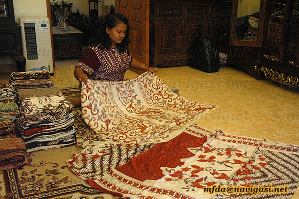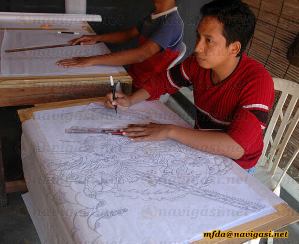 | |  | |  | | |
| | | [navigasi.net] Kerajinan - Batik Pesisir - Pekalongan
| |  | |  |
Since the Dutch colonial days, Pekalongan known as “Kota
Batik” or “Batik Town” and Pekalongan known for
its most famous “batik tulis” or “hand drawing
batik”. However, in recent years, there are not many
“batik tulis” producers, due to the growing
competition from the cheaper “batik cap” or
“stamped batik” which can be produced quicker and
cheaper.
There are many type of batik tulis produced in Pekalongan,
however one of the famous is called “batik pesisir”
(literally means: coastal batik) that managed to find its way
back to the glory days once it’s enjoyed. However, it had
gone through many changes in its motives (designs) and
coloration, to satisfy the consumer’s demands. The quality
and indeed price a good Batik Pesisir depends on the fabrics and
the so called “difficulty factors” and these factors
also determines the length of time in the production process and
in the end all go to its final price. The making of Batik Pesisir
could take 1 to 6 months and the prices vary accordingly, between
Rp 1 Million to Rp 6 Million.
The biggest production centers of Batik Pesisir is located in
Kemplong, Wiradesa. The writer visited one of the biggest
producer of Batik Pesisir. “Butik Failasuf” in
Kemplong, Wiradesa, accompanied by a charming gentleman, Mr
Taufik Hidayat, happens to be the Butik’s Marketing
Coordinator.
The process of making Batik Pesisir start with the type of the
fabrics, it is normally made of: Pure Cotton or Polyester Rayon
or Pure Silk. The raw fabrics are boiled in order to clean it
from the auxiliaries applied in the process of making it from the
textile factories.
 | |  | |  | | |
| | | [navigasi.net] Kerajinan - Batik Pesisir - Pekalongan
| |  | |  |
After this boiling process, the fabrics is dried and ironed
and send it to the design room, for the initial drawing of a
particular motives. Fabrics with drawing on it are sent to the
waxing process. In this section, we can see many young girls put
the wax on the drawings depending on the coloring process.
The process of making a batik tulis is delicate and indeed
complicated. The process of coloring can be back and forth many
times, depending on the motives of the batik and the number of
colors needed to be applied. The longer the process, the more
expensive the price of the batik is.
It was interesting and indeed fun watching the girls applying
the wax according to the drawing so quick yet with absolute
precision. The way the girls handled the “canting” or
“the wax writing instrument” is quite different from
one and another, as if it is different the way people holding the
pens when writing.
 | |  | |  | | |
| | | [navigasi.net] Kerajinan - Batik Pesisir - Pekalongan
| |  | |  |
During the wax writing process, after the girl putting the wax
liquid in the writing compartment, it seems necessary to blow air
to the pipe, in order to push any air bubbles that may still be
there, that will block the flow of wax in the pipe. It was a
great fun to see the girls blowing air to the pipe
PThere are so many motives of Batik Pesisir, namely: the the
Dutch motives (design), apparently is still popular these days.
Equally so the Chinese motives (design). Interestingly enough,
the Japanese motive (design) still hold a faithful customers as
well ...
While it sad to see, but perhaps it is also a blessing, to see
those young girls working. These girls normally drop out from
Junior High School and have to find job to support the family.
They earn around Rp 9.000.- or less than US$ 1.00 per day, yet
they seem very happy and smile never leave their beautiful and
innocent faces
God’s presence is everywhere and HE works
mysteriously.
|
